Introduction
Copyright protection is a cornerstone for any business that creates original content. Understanding how copyright works empowers business owners to protect their creative assets, avoid legal pitfalls, and maximize the value of their intellectual property. This guide walks you through the essentials, starting with what qualifies for copyright protection and how it automatically applies, then explaining the limited duration of rights and the eventual transition of works into the public domain. You will learn about the exclusive rights granted to copyright holders, the benefits and roles of registration and copyright notices, and the important limitations of copyright law. Finally, we’ll clarify how copyrights can be transferred, licensed, and effectively enforced, providing you with a comprehensive foundation to manage your business’s creative works confidently.
Tables of Contents
Chapter 1: How Copyright Works: Understanding Legal Protections and Eligibility
- Exclusive Rights and Legal Safeguards: Navigating Copyright Protections
- Defining Eligibility: What Makes a Work Qualify for Copyright Protection
Chapter 2: How Copyright Works: Duration and Public Domain Transition
- Navigating the Timeline: Understanding Copyright Duration and Public Domain Entry
- Unlocking Creativity: The Journey of Works into the Public Domain
Chapter 3: How Copyright Works: Exclusive Rights of Copyright Holders
- The Breadth of Exclusive Rights: How Copyright Holders Control and Monetize Creative Works
- Navigating Copyright Control: Transfers, Licensing, and Legal Boundaries
Chapter 4: How Copyright Works: The Role of Copyright Registration and Notices
- Enhancing Legal Protection: The Critical Impact of Copyright Registration and Notices
- The Critical Impact of Copyright Registration and Notices on Technology and Society
Chapter 5: How Copyright Works: Limitations and What Copyright Does Not Protect
- Navigating Copyright Boundaries: Why Ideas, Facts, and Government Works Remain Free
- Navigating Copyright Exceptions: Fair Use, First Sale, and Educational Freedoms
Chapter 6: How Copyright Works: Transfer, Licensing, and Enforcement of Rights
- Navigating Copyright Ownership: The Dynamics of Transferring and Licensing Rights
- Navigating Licensing and Enforcement: Protecting and Utilizing Copyright Effectively
Chapter 1: How Copyright Works: Understanding Legal Protections and Eligibility
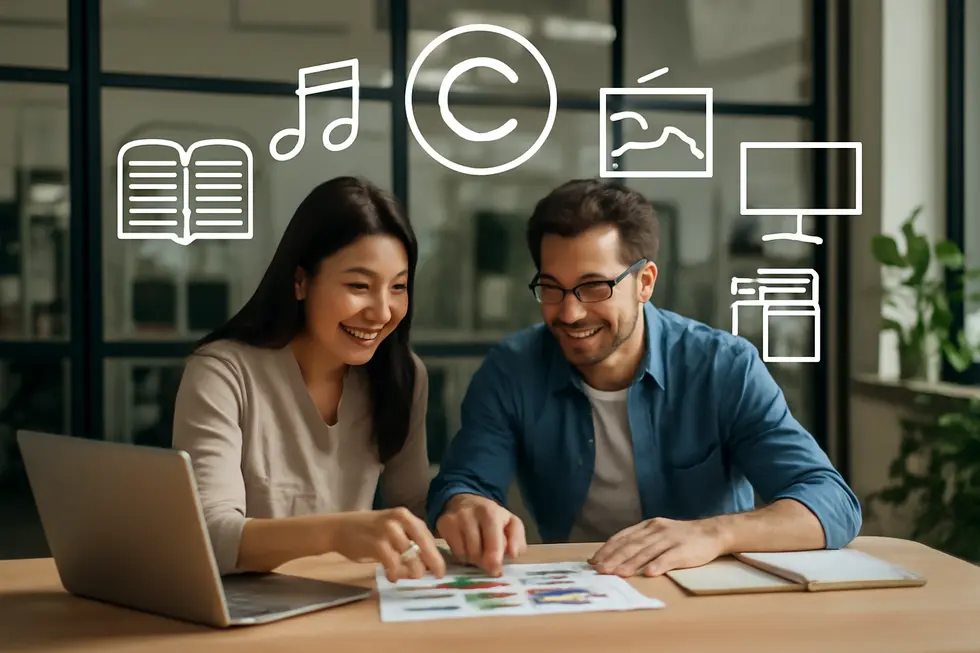
1. Exclusive Rights and Legal Safeguards: Navigating Copyright Protections
Exclusive Rights and Legal Safeguards: Navigating Copyright Protections
Copyright law provides creators with exclusive legal rights that protect their original works the moment they are fixed in a tangible medium. These rights empower authors, artists, musicians, and other creators to control how their works are copied, distributed, publicly displayed, performed, and adapted into derivative works. This legal framework is essential for safeguarding creative efforts and ensuring creators can benefit economically and morally from their work.
To qualify for copyright protection, a work must be original and embodied in a physical or digital form—pure ideas or concepts alone receive no protection. Once fixed, the copyright owner automatically holds several exclusive rights, including the ability to reproduce the work, prepare adaptations, distribute copies, perform or display it publicly, and authorize others to do so through licenses or transfers. These rights form the core of copyright’s protective power.
A critical aspect of copyright protection is its duration. For works created after January 1, 1978, protection lasts for the author’s lifetime plus 70 years. Anonymous creations or works made for hire enjoy a different term, lasting either 95 years from publication or 120 years from creation, whichever is shorter. After this period, the work enters the public domain and is freely accessible.
Although copyright protection arises automatically upon fixation, registering the work with the copyright office grants additional advantages. Registration facilitates legal enforcement by allowing the owner to pursue statutory damages and recover attorney fees in infringement cases. Enforcement typically involves documenting the unauthorized use, issuing cease and desist notices, leveraging DMCA takedown procedures for online infringements, and, if needed, litigating to uphold rights.
This system balances protecting creators’ exclusive rights while eventually enriching public access. The copyright law’s territorial limits are softened by international agreements like the Berne Convention, helping creators secure protections worldwide.
For a deeper dive into related protections and how copyright interacts with business, consult copyright language for business owners and more detailed guidance from the U.S. Copyright Office.
2. Defining Eligibility: What Makes a Work Qualify for Copyright Protection
Copyright protection hinges on two essential principles: originality and fixation. For a work to qualify, it must be independently created by the author and demonstrate at least a minimal degree of creativity. This originality requirement ensures that mere ideas or concepts, no matter how innovative, are not protected; copyright safeguards only the expression of ideas fixed in a tangible form. The second requirement, fixation, means the work must be captured in a stable, perceivable medium. This could be writing on paper, a recording on a digital device, or any form that allows the work to be communicated beyond a fleeting moment.
Copyright covers a wide range of original works of authorship, including literary pieces, musical compositions, visual arts, sound recordings, and audiovisual creations. However, certain works are excluded from protection, notably those produced by U.S. government employees during official duties—such government works enter the public domain immediately. Additionally, copyright does not protect facts, procedures, systems, or methods of operation, which belong to the realm of ideas and are free for public use.
Although copyright protection arises automatically upon fixation, registering the work with the U.S. Copyright Office offers substantial legal advantages. Registration is required to initiate an infringement lawsuit and allows copyright holders to pursue statutory damages and recover attorney’s fees, thus strengthening enforcement options.
Understanding these eligibility criteria clarifies the scope of copyright’s legal shield: it protects original expressions fixed in tangible forms while excluding mere ideas or government-authored works. For a deeper dive into eligibility standards and protection details, consult the comprehensive University of Michigan Library’s Copyright Basics guide.
This foundation is vital for creators and users alike to grasp how copyright law establishes the balance between protecting creative output and fostering public access.
Chapter 2: How Copyright Works: Duration and Public Domain Transition
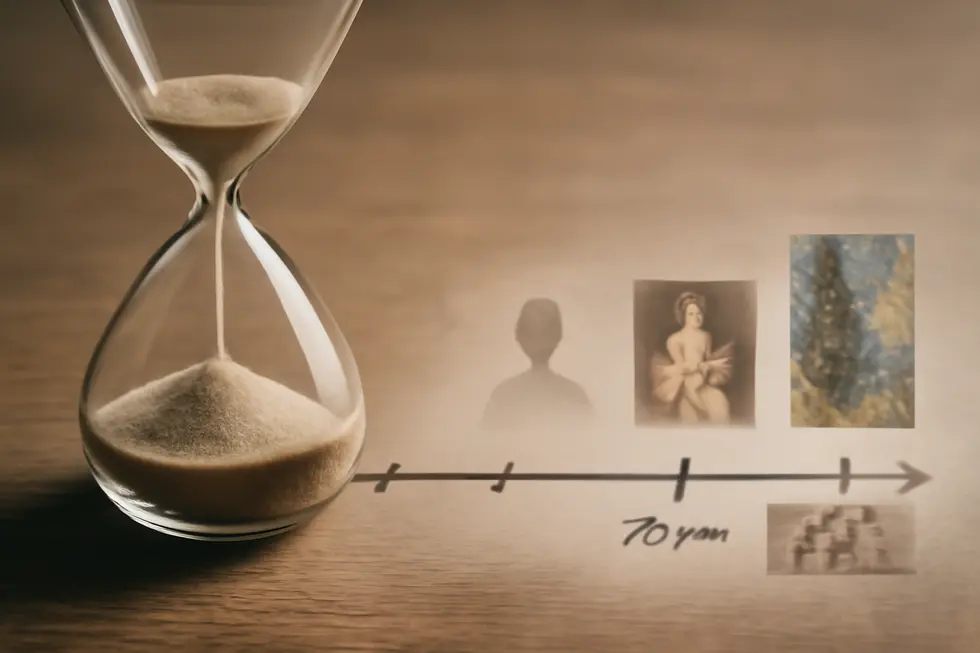
1. Navigating the Timeline: Understanding Copyright Duration and Public Domain Entry
Copyright duration is a fundamental aspect of how creators retain control over their original works. Its length varies primarily based on the type of work and the date it was created or published. For individual authors of literary, musical, or artistic works, copyright typically extends for the life of the creator plus 70 years in the U.S., though some jurisdictions use a 60-year term after death. When multiple authors collaborate, protection lasts until 70 years after the last surviving author’s death, ensuring all contributors’ rights are respected. Works published anonymously, pseudonymously, or corporate works, including most sound recordings, photographs, and government documents, often enjoy protection for fixed terms—usually 95 years from publication or 120 years from creation in the case of works made for hire, whichever expires first.
The transition of works into the public domain occurs automatically once these copyright terms expire, allowing unrestricted use by anyone. This opening of creative content is vital to cultural growth, enabling educators, artists, and the public to freely access and build upon previous works. For instance, in the United States, all works published before 1925 are now firmly in the public domain, with new works entering this status each year. Historically, copyright duration was less straightforward. Prior to 1978, formalities such as registration and renewal were required, and terms were shorter. The 1998 Sonny Bono Copyright Term Extension Act lengthened U.S. copyright terms by 20 years, temporarily halting the flow of works into the public domain but resuming gradual releases starting in 2019.
Determining the precise copyright term for older or complex works can be challenging. Trusted resources like the University of Michigan Copyright Guide provide detailed information on duration and public domain transitions. This helps creators and users alike navigate which works they may legally use without permission, balancing the protection of creators’ rights with the promotion of access and innovation.
For more about how copyright intersects with business and content use, see our detailed discussion on copyright law and the public domain.
2. Unlocking Creativity: The Journey of Works into the Public Domain
Copyright protection is designed to be temporary, ensuring that after a defined period, creative works become accessible for anyone to use freely. In the United States, this transition to the public domain happens when the copyright term expires—typically 70 years after the author’s death for works created after 1977, or 95 years after publication for earlier works. However, the shift is always effective from January 1st of the year after the copyright expires, maintaining a clear and predictable timeline for public access.
This process is pivotal because once a work enters the public domain, its protections expire, removing any legal restrictions on copying, adapting, or distributing the original material. Organizations such as libraries and museums can then provide expanded public access, significantly enriching cultural and educational resources. Moreover, new creators can build upon these works without infringing on anyone’s rights, fostering innovation and creative reinterpretation.
Some works may enter the public domain sooner if essential copyright formalities, like registration or renewal, were overlooked. Additionally, authors can proactively relinquish rights by voluntarily dedicating their creations to the public domain, accelerating access. Despite this freedom, certain limitations may still apply if other laws govern the content, such as restrictions on classified information.
This balance between protecting creators’ interests and enabling public use illustrates copyright’s core purpose: to encourage the creation of art and knowledge, while ensuring that these cultural treasures eventually become shared assets for society. For a deeper understanding of how copyright terms shape the availability of works, additional insights can be found at the Copyright Law and Public Domain resource and the Naval War College LibGuide on Copyright and Public Domain.
Chapter 3: How Copyright Works: Exclusive Rights of Copyright Holders
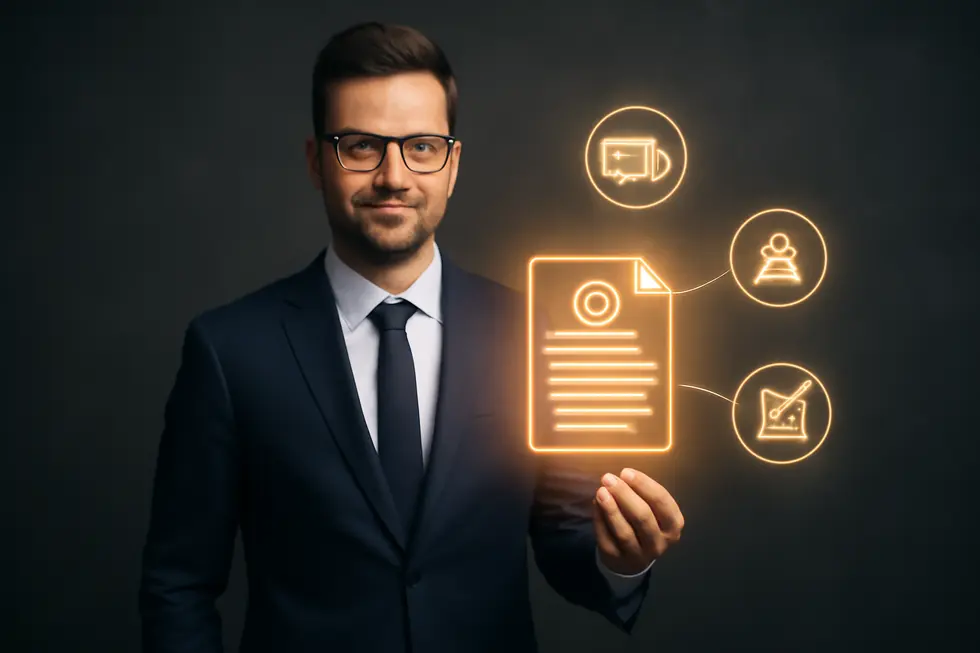
1. The Breadth of Exclusive Rights: How Copyright Holders Control and Monetize Creative Works
Copyright grants creators a set of exclusive legal rights that empower them to control how their original works are used and shared. These works must be fixed in a tangible medium—such as writing, recording, or digital files—to be protected. The core exclusive rights include the ability to reproduce the work by making copies in any format, whether physical or digital, ensuring the author controls replication.
Another essential right is distribution, which enables copyright holders to decide how and when their works are sold, rented, lent, or gifted to the public. Public performance rights cover the playing or presentation of works like music, plays, or films in public venues or broadcasts. Similarly, public display rights protect visual works, such as paintings and photographs, from being publicly shown without authorization.
The right to create derivative works allows copyright holders to authorize adaptations, translations, or other transformations that build upon the original expression. This comprehensive bundle of rights lets creators manage and monetize their intellectual property effectively.
Ownership initially vests in the creator but can shift through written agreements. For example, employers typically own copyrights to works produced by employees within their roles, while freelancers may transfer rights via contracts specifying “work made for hire” status. Copyright owners can license or assign rights, fully or partially, temporarily or permanently, to others.
These exclusive rights do not protect abstract ideas, facts, or methods but the specific expression fixed in a tangible form. They last for a considerable term—generally the author’s lifetime plus 70 years, or for corporate-created works, up to 95 years from publication. Once expired, works enter the public domain, where free use applies.
For further details on how copyright protections impact business distribution, review this guide on copyright distribution rights. More comprehensive federal provisions are available through the U.S. Copyright Office.
2. Navigating Copyright Control: Transfers, Licensing, and Legal Boundaries
Navigating Copyright Control: Transfers, Licensing, and Legal Boundaries
Copyright endows creators with exclusive rights over their original works, allowing them to control reproduction, distribution, public performance, public display, and the creation of derivative works. These rights not only empower authors, artists, and producers but also form a strategic asset that can be managed in various ways to maximize value and protect creative interests.
One primary method of managing these rights is through transfer of ownership, where the original copyright holder fully relinquishes all rights to another party. This transfer grants the new owner complete control over how the work is used and monetized. Such transfers are commonplace in sectors like academic publishing, where authors often assign copyrights to publishers as part of the publication agreement, thus enabling publishers to exploit the work commercially and control its dissemination.
Alternatively, copyright holders can retain ownership while granting others permission to use the work through licensing agreements. Licenses come in two main forms: exclusive and non-exclusive. An exclusive license awards sole usage rights to one licensee within a defined scope and duration, resembling ownership without complete transfer. For example, an author might grant a publisher exclusive rights for print distribution while licensing digital rights separately to other parties. Non-exclusive licenses, by contrast, allow multiple parties concurrent use under stipulated terms, supporting broader distribution without sacrificing ownership.
Despite these strong exclusive rights, certain legal limitations apply. Notably, the doctrine of fair use permits limited, unauthorized uses of copyrighted material for purposes like criticism, commentary, news reporting, teaching, and research. Such exceptions ensure that copyright law balances creators’ rights with public interest, preventing undue restriction of information flow and cultural discourse.
Understanding how copyright rights can be transferred, licensed, and legally limited is essential for creators and businesses alike. Effective management of these rights allows for strategic control over creative works, fostering both protection and innovation. For a detailed guide on copyright rights and licensing practices, see the University of Portland’s explanation on copyright rights and licensing.
Chapter 4: How Copyright Works: The Role of Copyright Registration and Notices
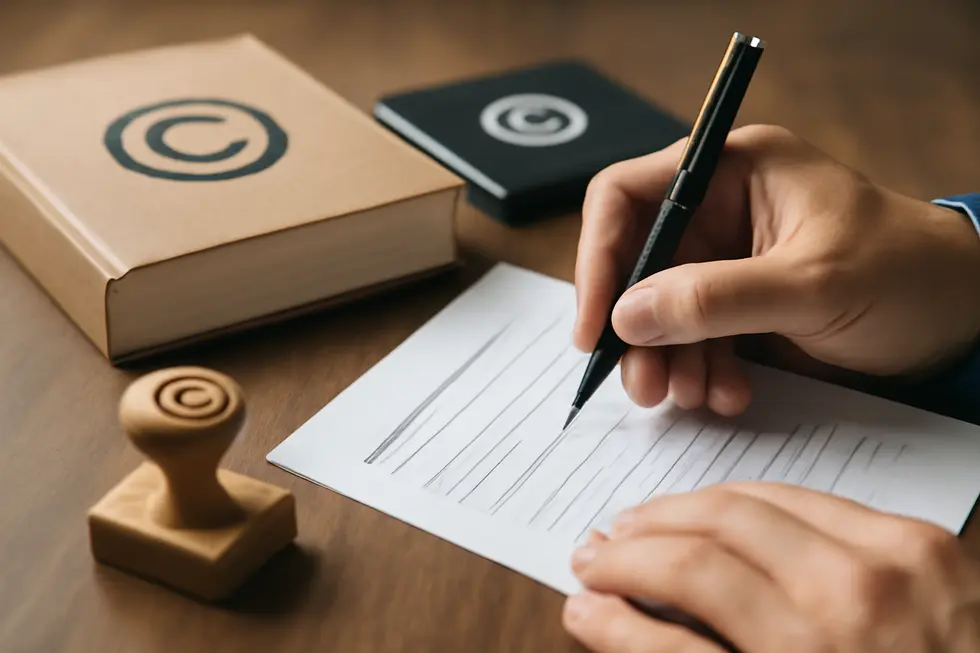
1. Enhancing Legal Protection: The Critical Impact of Copyright Registration and Notices
Copyright protection begins automatically the moment an original work is fixed in a tangible form, such as writing or recording. However, while this automatic protection grants creators exclusive rights, it is through copyright registration and notices that these rights gain stronger legal reinforcement. Registration with the U.S. Copyright Office is a prerequisite before filing an infringement lawsuit, establishing an official public record of ownership and offering vital legal advantages. A key benefit of timely registration—done before or within three months of publication—is that it enables the copyright owner to pursue statutory damages and attorney’s fees in court. Without registration, the remedies for infringement are limited to actual damages and any profits resulting from unauthorized use. This contrast highlights the importance of registration as a strategic tool for creators to maximize enforcement options and legal recovery.
Meanwhile, the role of copyright notices, though no longer mandatory since the United States’ adherence to the Berne Convention in 1989, remains significant. The © symbol, combined with the year of first publication and the owner’s name, serves as a clear public declaration of ownership. This warning discourages infringement claims based on ignorance, which courts recognize as “innocent infringement.” By eliminating such claims, notices can lead to higher damages awarded against infringers. Additionally, they provide an accessible way for potential licensees or users to identify the copyright holder, helping prevent unauthorized use before conflicts arise.
Together, registration and notices fortify the practical enforceability of copyright by converting an automatic right into a legally assertable and economically valuable asset. This enhanced protection supports creators in defending their works across a variety of formats—including literature, music, art, and digital media—and empowers them to pursue remedies effectively when their rights are violated. Detailed guidance on the registration process, including application submission and fees, is available from the U.S. Copyright Office’s official resources.
For creators and rights holders aiming to understand the nuances of protecting their work’s value, effective use of copyright registration and notices is foundational. More insights into copyright protections and how they apply to various scenarios can be explored at copyright information example for business.
U.S. Copyright Office – Registration Process and Benefits
2. The Critical Impact of Copyright Registration and Notices on Technology and Society
Copyright protection begins the moment an original work is fixed in a tangible form, but formal copyright registration and notices play a pivotal role in maximizing its practical benefits. Registration is a process whereby creators submit an application, deposits of their work, and proof of authorship to a copyright office, securing a publicly accessible record. This formal acknowledgment strengthens legal standing, enabling rights holders to pursue statutory damages and attorney’s fees in infringement cases. Beyond legal advantages, this public record clarifies ownership, promoting transparency and encouraging lawful licensing arrangements.
Technologically, registration supports automated content identification systems, such as digital fingerprinting tools used by online platforms to detect unauthorized use. These systems rely on registered works as reference data, enabling faster and more accurate identification of infringements. Advances in artificial intelligence and machine learning further refine these tools to distinguish between infringement and lawful exceptions like fair use, improving enforcement without hindering creativity. Moreover, rights holders benefit from global monitoring capabilities that track content across jurisdictions, facilitating cross-border enforcement in an interconnected digital environment.
Society gains from the balance this system provides. By inviting public objections during registration, the process fosters dispute resolution and accountability. It also reinforces the social contract embedded in copyright law: creators receive exclusive rights to control and profit, while the public eventually gains access as works enter the public domain. Registration and notices thus embody a critical interface where legal protections meet evolving technological ecosystems and public interest considerations.
For businesses and creators seeking more context about how copyright fosters public access and ownership clarity, resources like copyright law and public domain offer detailed insights into these dynamics.
Together, registration and notices form essential mechanisms that empower creators, harness technology, and support society’s complex relationship with intellectual property.
Chapter 5: How Copyright Works: Limitations and What Copyright Does Not Protect
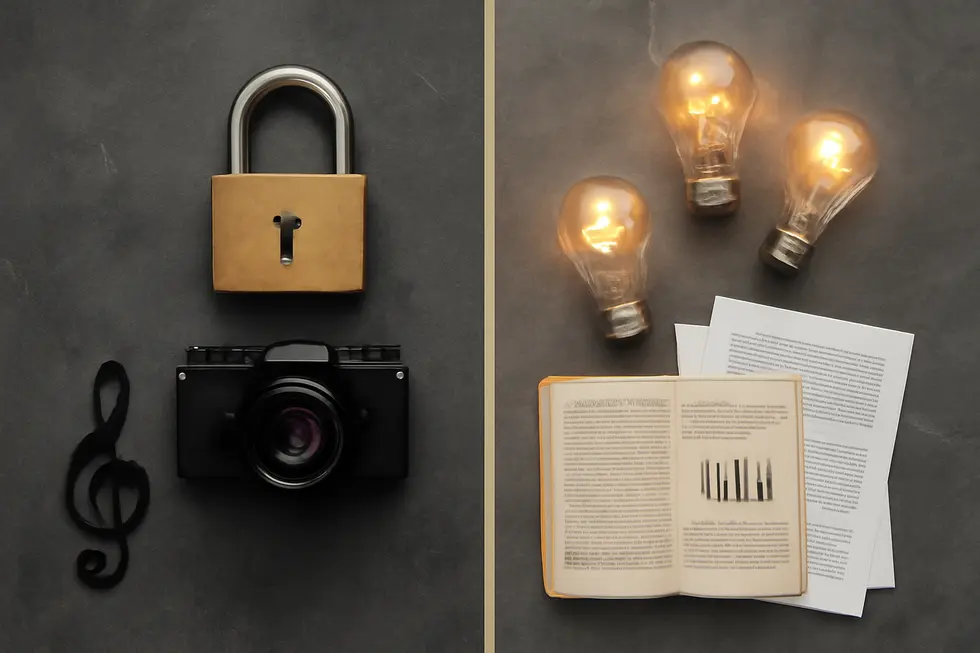
1. Navigating Copyright Boundaries: Why Ideas, Facts, and Government Works Remain Free
Copyright law carefully distinguishes between the protection of original expressions and the free use of ideas, facts, and certain government works. This distinction is essential because copyright does not grant ownership over ideas themselves, only the unique way those ideas are expressed. For instance, a scientific fact or historical event cannot be copyrighted; the protection extends solely to the specific wording, arrangement, or creative presentation of that information. This principle safeguards the flow of knowledge while rewarding creative expression.
A critical limitation is the idea/expression dichotomy, which prevents copyright from monopolizing the underlying concept behind a work. Similarly, the scènes à faire doctrine excludes from protection any elements that are standard or inevitable within a particular genre, such as familiar plot devices in detective fiction or common photographic angles. These conventions are considered necessary building blocks for new creators rather than original expressions warranting exclusive rights.
The merger doctrine further restricts copyright where the expression is inseparable from the idea because only a limited number of ways exist to convey it. Simple phrases, commonly known facts, or factual statements often fall under this rule, ensuring no excessive claim over fundamental information. Moreover, government works produced by federal employees in official duties are excluded from copyright protection altogether, promoting public access to governmental materials.
Together, these limitations prevent overreach and encourage creativity and innovation by distinguishing protectable original works from unprotectable ideas and facts. After the copyright term expires, works enter the public domain, allowing unrestricted use. Understanding these boundaries clarifies what requires permission for use and what is free for public benefit.
For more comprehensive explanations of these principles, resources like the U.S. Copyright Office’s guidelines and the detailed insights from the University of Michigan Library offer valuable information. To explore how copyright interacts with business contexts, consider this guide on copyright distribution rights.
2. Navigating Copyright Exceptions: Fair Use, First Sale, and Educational Freedoms
Copyright law grants creators exclusive control over their original works but recognizes important exceptions that balance these rights with public interest. Among the most significant exceptions are fair use, the first sale doctrine, and specific allowances for educational purposes.
Fair use permits limited use of copyrighted materials without the creator’s permission under circumstances like criticism, commentary, news reporting, teaching, scholarship, or research. Determining fair use involves a nuanced, case-by-case assessment of four factors—how the work is used (including whether the use adds new meaning or context), the nature of the original work, the amount of material used, and how the use impacts the work’s market value. This flexible doctrine supports freedom of expression and educational access but is not an automatic exemption simply because the use is for teaching.
The first sale doctrine protects buyers of lawful copies, allowing them to resell, lend, or give away that particular copy without needing approval from the copyright owner. This ensures that once a work—like a book or DVD—is purchased, the owner controls what happens with that physical or digital copy, fostering secondary markets and sharing.
Educational uses have tailored allowances recognizing their societal importance. Teachers may display or perform copyrighted works directly in face-to-face classrooms or certain distance education settings without permission, provided the materials are lawfully acquired and used appropriately. Libraries and archives can replicate works for preservation, patron use, and sharing among institutions. While limited distribution of copies for classroom use is allowed in infrequent cases, repeated copying generally requires permission. The classroom use exemption specifically protects instructional, non-entertainment use of materials but excludes online protocols that do not mirror in-person teaching environments.
Collectively, these exceptions preserve copyright holders’ rights while advancing education, scholarship, and broader cultural engagement. Detailed provisions are outlined in Sections 107 through 122 of the U.S. Copyright Act. For further practical guidance on fair use, the University of Memphis Copyright Guide on Fair Use offers an excellent resource.
Chapter 6: How Copyright Works: Transfer, Licensing, and Enforcement of Rights
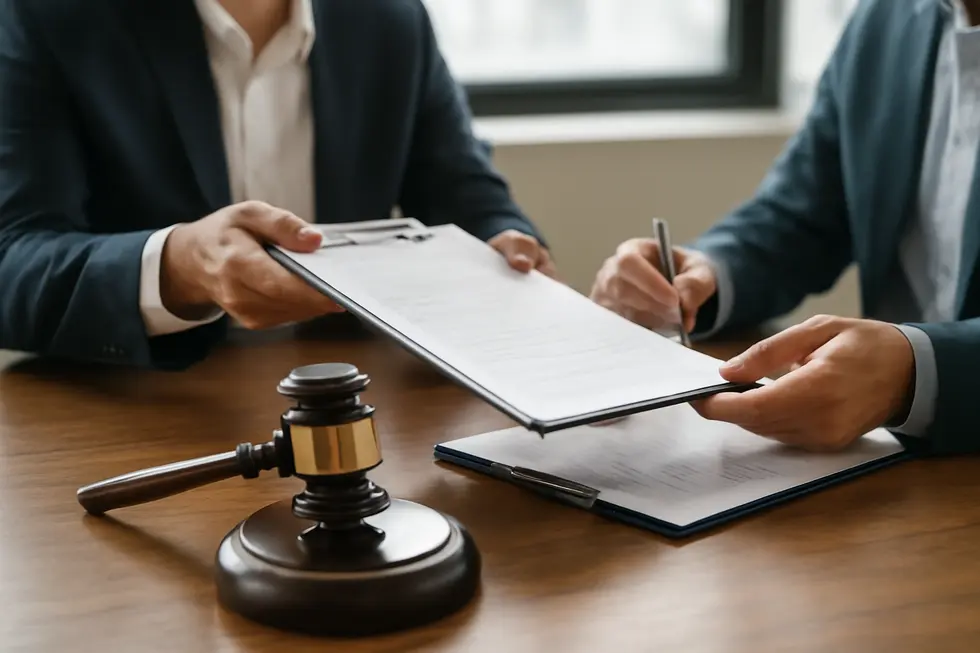
1. Navigating Copyright Ownership: The Dynamics of Transferring and Licensing Rights
Copyright ownership conveys powerful exclusive rights over creative works, but these rights can shift through transfer or licensing—each with distinct legal implications. When an author or original copyright holder decides to transfer rights, they relinquish full ownership. This transfer is typically formalized through a written and signed agreement, ensuring the new owner gains complete control over reproduction, distribution, public display, performance, and creation of derivative works. This legal process is fundamental in industries like publishing, where authors often transfer copyrights to publishers to facilitate dissemination and commercialization. The transfer agreement meticulously defines the intellectual property involved, the scope of the rights granted, conditions of use, payment terms, and other provisions like indemnification and dispute resolution to protect both parties.
Contrasting with transfer, licensing permits a third party to use the copyrighted work without surrendering ownership. Licenses can be exclusive—granting sole usage rights—or non-exclusive, allowing multiple licensees simultaneously. Licensing agreements often include terms for royalties or fees and can specify rights related to derivative works, clarifying ownership and enforcement responsibilities. This flexibility allows creators and rights holders to maximize their work’s reach while retaining ultimate control.
Once rights transfer is complete, the new copyright owner assumes the authority to enforce those rights. This includes issuing cease and desist notices, requesting removal of infringing content through DMCA takedown procedures, and pursuing legal remedies against violations. Without such transfer or explicit licensing, original creators maintain sole enforcement capacity.
Understanding these nuances—the clear distinction between transfer and licensing, the importance of carefully drafted agreements, and how enforcement aligns with ownership—is essential for anyone navigating copyright management. For a deeper exploration of how intellectual property rights transfer agreements are structured and executed, this comprehensive guide offers valuable insights.
Additionally, business owners interested in how copyright impacts the distribution of their creative content may find useful information at copyright distribution rights for business.
2. Navigating Licensing and Enforcement: Protecting and Utilizing Copyright Effectively
Licensing and enforcement form the backbone of practical copyright management, enabling creators to control use while safeguarding their rights. Licensing is an arrangement where the copyright owner authorizes another party to use the work under specific conditions without giving up ownership. These licenses can be non-exclusive, permitting multiple users simultaneously, or exclusive, granting sole usage rights for defined purposes or durations. This flexibility allows creators to monetize or share their work strategically while retaining varying degrees of control.
In contrast, copyright transfer entails a complete legal assignment of ownership from the original creator to another entity. Such transfers must be formalized in writing and signed to be enforceable. This process is common in publishing or media industries, where authors or artists relinquish their copyrights to publishers or production companies, who then assume responsibility for reproduction and distribution.
Enforcement is critical to preserving these licensed or transferred rights. When infringement occurs, it begins with documenting unauthorized use thoroughly. Often, the first step involves sending a cease and desist letter to halt infringing activity, which may lead to amicable resolution through licensing agreements or withdrawal. For digital content, a DMCA takedown notice offers a streamlined mechanism to remove infringing material from hosting platforms promptly.
If informal efforts fail, rights holders may pursue legal action seeking injunctive relief and damages. In rare, severe cases involving organized piracy, criminal prosecution can occur. Additionally, copyright enforcement confronts challenges posed by “copyright trolls”—entities that aggressively demand settlements for alleged infringements, sometimes targeting businesses over unintentional misuse.
Effective copyright management also requires clear license terms regarding derivative works to prevent disputes over newly created content based on original material. Combining precise licensing or transfer agreements with vigilant enforcement strategies ensures that creators can both capitalize on and protect their intellectual property over time.
For more insight into the legal framework supporting copyright licensing and enforcement, see this resource on copyright language for business owners.
Final thoughts
Copyright law is fundamental for business owners to safeguard the originality and value of their creative works. By understanding who qualifies for protection, how long these rights last, and what specific controls copyright grants, business owners can strategically protect their assets. Recognizing the importance of registration and notices adds a layer of security, while awareness of copyright limitations keeps expectations realistic. Lastly, mastering rights transfer, licensing, and enforcement ensures that these valuable assets remain a solid foundation for ongoing business success. Taking these steps equips you to turn your creative output into protected, profitable assets that support and grow your enterprise.
Your IP is the foundation of your success – let’s protect it together before it’s too late. We can’t wait to help you turn your ideas into legally secured assets.
About us
undefined
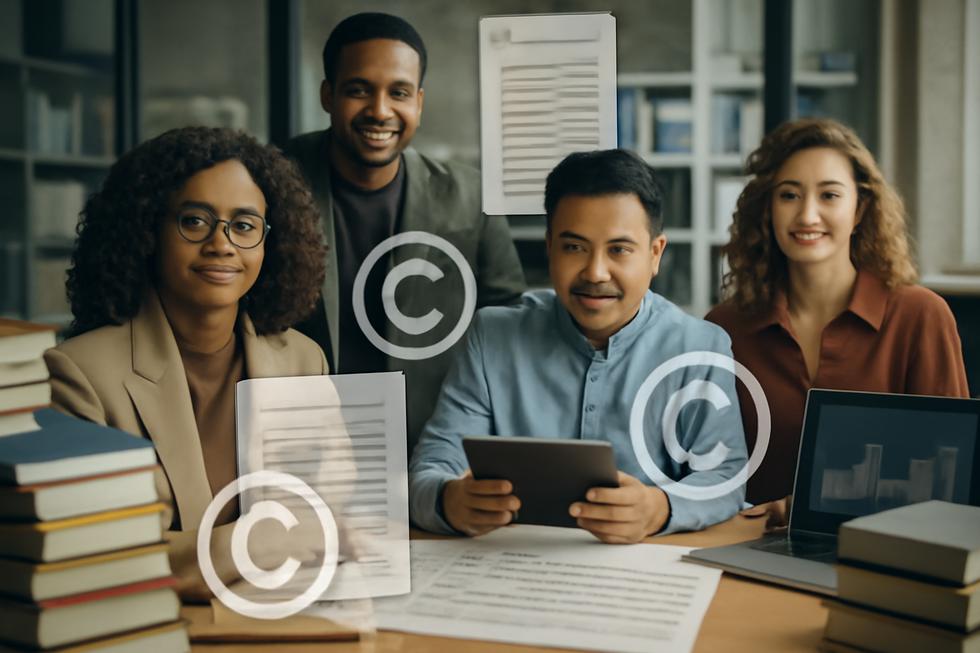


I don’t think the title of your article matches the content lol. Just kidding, mainly because I had some doubts after reading the article. https://accounts.binance.com/ro/register?ref=HX1JLA6Z